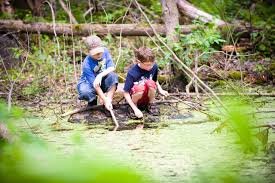The Benefits of Outdoor Environmental Education
Outdoor environmental education plays a crucial role in fostering a deeper connection with nature and promoting sustainable practices. By taking learning outside the traditional classroom setting, students of all ages have the opportunity to engage with the natural world in a hands-on and immersive way. This approach not only enhances academic learning but also instills a sense of responsibility and stewardship for the environment.
Hands-On Learning
One of the primary benefits of outdoor environmental education is the opportunity for hands-on learning experiences. Whether students are exploring local ecosystems, conducting field research, or participating in conservation activities, they are actively engaging with their environment. This direct interaction allows for a deeper understanding of ecological principles and fosters a sense of curiosity and wonder about the natural world.
Physical Health and Well-Being
Spending time outdoors has been shown to have numerous health benefits, including reducing stress levels, improving mood, and increasing physical activity. Outdoor environmental education provides students with the opportunity to disconnect from screens and technology and instead connect with nature. This can lead to improved mental health, increased physical fitness, and a greater appreciation for the beauty of the natural world.
Environmental Stewardship
By immersing students in outdoor environmental education programs, educators can help cultivate a sense of environmental stewardship and responsibility. When students develop a personal connection to nature through direct experiences in the outdoors, they are more likely to develop an ethic of care for the environment. This can lead to lifelong habits of sustainability and conservation that benefit both local ecosystems and the planet as a whole.
Interdisciplinary Learning
Outdoor environmental education provides a unique opportunity for interdisciplinary learning by integrating concepts from various subject areas such as science, geography, history, and art. By exploring nature from multiple perspectives, students can gain a holistic understanding of complex environmental issues and develop critical thinking skills that are essential for addressing global challenges related to climate change, biodiversity loss, and resource management.
Conclusion
In conclusion, outdoor environmental education offers numerous benefits for students, educators, and communities alike. By providing opportunities for hands-on learning, promoting physical health and well-being, fostering environmental stewardship, and encouraging interdisciplinary exploration, outdoor environmental education plays a vital role in shaping environmentally literate citizens who are equipped to address pressing ecological issues facing our planet.
Exploring the Essentials of Outdoor Environmental Education: Benefits, Activities, and Implementation Strategies
- What is outdoor environmental education?
- Why is outdoor environmental education important?
- How does outdoor environmental education benefit students?
- What are some examples of outdoor environmental education activities?
- How can schools and organizations implement outdoor environmental education programs?
What is outdoor environmental education?
Outdoor environmental education is a dynamic and experiential approach to learning that takes place in natural settings such as forests, wetlands, mountains, and parks. It involves engaging with the environment through hands-on activities, exploration, and observation to deepen understanding of ecological concepts and foster a sense of connection with nature. Outdoor environmental education goes beyond traditional classroom learning by immersing participants in real-world experiences that promote environmental stewardship, critical thinking skills, and a holistic appreciation for the natural world. By integrating outdoor experiences with educational goals, outdoor environmental education encourages individuals of all ages to become active participants in caring for the environment and promoting sustainable practices.
Why is outdoor environmental education important?
Outdoor environmental education is important because it fosters a deep connection with nature, promotes hands-on learning experiences, and instills a sense of environmental stewardship. By taking learning outside the classroom and immersing students in the natural world, outdoor environmental education allows individuals to develop a greater appreciation for the environment and its intricate ecosystems. This direct interaction with nature not only enhances academic knowledge but also encourages the development of sustainable practices and a lifelong commitment to protecting our planet. Ultimately, outdoor environmental education plays a vital role in cultivating environmentally conscious citizens who are equipped to address pressing environmental challenges and contribute to a more sustainable future.
How does outdoor environmental education benefit students?
Outdoor environmental education benefits students in numerous ways. By taking learning outside the classroom and into nature, students have the opportunity to engage in hands-on experiences that deepen their understanding of ecological principles and foster a sense of connection to the natural world. This direct interaction with the environment not only enhances academic learning but also promotes physical health, mental well-being, and environmental stewardship. Through outdoor environmental education, students develop critical thinking skills, gain a deeper appreciation for biodiversity, and cultivate a sense of responsibility for protecting and preserving our planet for future generations.
What are some examples of outdoor environmental education activities?
Outdoor environmental education activities encompass a wide range of engaging experiences that connect participants with the natural world. Some examples include nature hikes where participants learn about local flora and fauna, bird watching to observe avian species in their habitats, tree planting initiatives to contribute to reforestation efforts, water quality testing in streams or ponds to understand ecosystem health, and camping trips that immerse individuals in outdoor living skills and leave-no-trace principles. These hands-on activities not only educate participants about environmental concepts but also foster a sense of appreciation and responsibility for the environment.
How can schools and organizations implement outdoor environmental education programs?
Schools and organizations can implement outdoor environmental education programs by first establishing clear learning objectives and identifying resources needed for program development. They can integrate outdoor activities into existing curricula, collaborate with local environmental experts and community partners, and provide training for educators on outdoor teaching methods. Creating safe and inclusive outdoor learning environments, securing necessary permits for field trips, and incorporating reflection and assessment components are also essential steps in successfully implementing outdoor environmental education programs. By prioritizing hands-on experiences, fostering a sense of environmental stewardship, and engaging students in meaningful interactions with nature, schools and organizations can create impactful outdoor education initiatives that inspire a lifelong connection to the environment.

